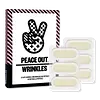What's inside
What's inside
 Key Ingredients
Key Ingredients

 Benefits
Benefits

 Concerns
Concerns

 Ingredients Side-by-side
Ingredients Side-by-side

Sodium Hyaluronate
HumectantCellulose Gum
Emulsion StabilisingTrehalose
HumectantGlycerin
HumectantPropanediol
SolventButylene Glycol
HumectantCaprylyl Glycol
EmollientRetinol
Skin ConditioningAdenosine
Skin ConditioningCarnosine
Skin ConditioningAscorbic Acid
AntioxidantPalmitoyl Tripeptide-1
Skin ConditioningBiotinoyl Hexapeptide-2 Amide
Skin ConditioningAcetyl Octapeptide-3
HumectantPalmitoyl Pentapeptide-4
Skin ConditioningPalmitoyl Tetrapeptide-7
Skin ConditioningAcetyl Hexapeptide-8
HumectantHeptasodium Hexacarboxymethyl Dipeptide-12
Skin ConditioningMelatonin
AntioxidantMadecassoside
AntioxidantEthylhexylglycerin
Skin ConditioningCarbomer
Emulsion StabilisingPolysorbate 80
EmulsifyingPolysorbate 20
Emulsifying1,2-Hexanediol
Skin ConditioningSodium Lactate
BufferingSodium Hyaluronate, Cellulose Gum, Trehalose, Glycerin, Propanediol, Butylene Glycol, Caprylyl Glycol, Retinol, Adenosine, Carnosine, Ascorbic Acid, Palmitoyl Tripeptide-1, Biotinoyl Hexapeptide-2 Amide, Acetyl Octapeptide-3, Palmitoyl Pentapeptide-4, Palmitoyl Tetrapeptide-7, Acetyl Hexapeptide-8, Heptasodium Hexacarboxymethyl Dipeptide-12, Melatonin, Madecassoside, Ethylhexylglycerin, Carbomer, Polysorbate 80, Polysorbate 20, 1,2-Hexanediol, Sodium Lactate
Squalane
EmollientDiisostearyl Malate
EmollientCeresin
Emulsion StabilisingPolyethylene
AbrasiveMica
Cosmetic ColorantBis-Diglyceryl Polyacyladipate-2
EmollientSynthetic Wax
AbrasiveCaprylic/Capric Triglyceride
MaskingSilica Dimethyl Silylate
EmollientEthylene/Propylene Copolymer
AbrasiveGlycerin
HumectantCaprylyl Glycol
EmollientCarthamus Tinctorius Seed Oil
MaskingRetinol
Skin ConditioningOleic Acid
EmollientPolysorbate 20
EmulsifyingLecithin
EmollientPolycaprolactone
StabilisingTerminalia Arjuna Extract
Skin ConditioningUbiquinone
AntioxidantAstaxanthin
Skin ConditioningOryza Sativa Bran Wax
Skin ConditioningBakuchiol
AntimicrobialSodium Hyaluronate
HumectantPhaseolus Radiatus Seed Extract
Skin ConditioningAcmella Oleracea Extract
Skin ProtectingCeramide NP
Skin ConditioningBiotinoyl Hexapeptide-2 Amide
Skin ConditioningHeptasodium Hexacarboxymethyl Dipeptide-12
Skin ConditioningSpilanthes Acmella Flower/Leaf/Stem Extract
AntimicrobialAstragalus Membranaceus Root Extract
EmollientHaematococcus Pluvialis Extract
AntioxidantOlea Europaea Fruit Oil
MaskingPsoralea Corylifolia Seed Extract
Skin ConditioningAvena Sativa Meal Extract
SoothingTocopherol
Antioxidant1,2-Hexanediol
Skin ConditioningWater
Skin ConditioningSodium Magnesium Silicate
Squalane, Diisostearyl Malate, Ceresin, Polyethylene, Mica, Bis-Diglyceryl Polyacyladipate-2, Synthetic Wax, Caprylic/Capric Triglyceride, Silica Dimethyl Silylate, Ethylene/Propylene Copolymer, Glycerin, Caprylyl Glycol, Carthamus Tinctorius Seed Oil, Retinol, Oleic Acid, Polysorbate 20, Lecithin, Polycaprolactone, Terminalia Arjuna Extract, Ubiquinone, Astaxanthin, Oryza Sativa Bran Wax, Bakuchiol, Sodium Hyaluronate, Phaseolus Radiatus Seed Extract, Acmella Oleracea Extract, Ceramide NP, Biotinoyl Hexapeptide-2 Amide, Heptasodium Hexacarboxymethyl Dipeptide-12, Spilanthes Acmella Flower/Leaf/Stem Extract, Astragalus Membranaceus Root Extract, Haematococcus Pluvialis Extract, Olea Europaea Fruit Oil, Psoralea Corylifolia Seed Extract, Avena Sativa Meal Extract, Tocopherol, 1,2-Hexanediol, Water, Sodium Magnesium Silicate
 Reviews
Reviews

Ingredients Explained
These ingredients are found in both products.
Ingredients higher up in an ingredient list are typically present in a larger amount.
1,2-Hexanediol is a synthetic liquid and another multi-functional powerhouse.
It is a:
- Humectant, drawing moisture into the skin
- Emollient, helping to soften skin
- Solvent, dispersing and stabilizing formulas
- Preservative booster, enhancing the antimicrobial activity of other preservatives
Biotinoyl Hexapeptide-2 Amide is a peptide.
Caprylyl Glycol is a humectant and emollient, meaning it attracts and preserves moisture.
It is a common ingredient in many products, especially those designed to hydrate skin. The primary benefits are retaining moisture, skin softening, and promoting a healthy skin barrier.
Though Caprylyl Glycol is an alcohol derived from fatty acids, it is not the kind that can dry out skin.
This ingredient is also used as a preservative to extend the life of products. It has slight antimicrobial properties.
Learn more about Caprylyl GlycolGlycerin is already naturally found in your skin. It helps moisturize and protect your skin.
A study from 2016 found glycerin to be more effective as a humectant than AHAs and hyaluronic acid.
As a humectant, it helps the skin stay hydrated by pulling moisture to your skin. The low molecular weight of glycerin allows it to pull moisture into the deeper layers of your skin.
Hydrated skin improves your skin barrier; Your skin barrier helps protect against irritants and bacteria.
Glycerin has also been found to have antimicrobial and antiviral properties. Due to these properties, glycerin is often used in wound and burn treatments.
In cosmetics, glycerin is usually derived from plants such as soybean or palm. However, it can also be sourced from animals, such as tallow or animal fat.
This ingredient is organic, colorless, odorless, and non-toxic.
Glycerin is the name for this ingredient in American English. British English uses Glycerol/Glycerine.
Learn more about GlycerinHeptasodium Hexacarboxymethyl Dipeptide-12 is a peptide.
Polysorbate 20 is made by combining ethoxylation of sorbitan, ethylene oxide, and lauric acid. It is a mild cleansing agent, surfactant, and emulsifier.
As a surfactant, it helps collect dirt and oils for washing. Emulsifiers prevent oils and water from separating.
Polysorbate 20 also adds scent to a product. Since it is made using sorbitol, it has a sweet scent. Sorbitol can also be found in fruits such as apples and peaches.
The lauric acid used to create Polysorbate 20 is often derived from coconuts.
Polysorbate 20 may not be fungal acne safe.
Learn more about Polysorbate 20Retinol is a gold-standard ingredient for anti-aging. It is a form of Vitamin A and belongs to the class of retinoids that also includes tretinoin.
Why is retinol famous?
It has the most scientific studies backing up its skin benefits out of all the non-prescription ingredients.
Retinol is proven to:
This is why retinol is effective at removing wrinkles, fading dark spots, treating acne, and reducing the appearance of pores.
Studies show retinol is less effective when exposed to UV. Be sure to look for appropriate packaging to keep your retinol potent (similar to Vitamin C).
Using retinol or any retinoids will increase sun-sensitivity in the first few months. Though studies show retinoids increase your skin's natural SPF with continuous use, it is best to always wear sunscreen and sun-protection.
We recommend speaking with a medical professional about using this ingredient during pregnancy.
Retinol may cause irritation in some people, so be sure to patch test. Experts recommend 'ramping up' retinol use: start using this ingredient once a week and work up to using it daily.
Read about Tretinoin
Learn more about RetinolSodium Hyaluronate is hyaluronic acid's salt form. It is commonly derived from the sodium salt of hyaluronic acid.
Like hyaluronic acid, it is great at holding water and acts as a humectant. This makes it a great skin hydrating ingredient.
Sodium Hyaluronate is naturally occurring in our bodies and is mostly found in eye fluid and joints.
These are some other common types of Hyaluronic Acid:
Learn more about Sodium Hyaluronate